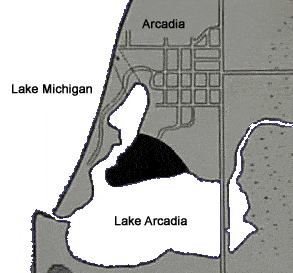Native Americans in Arcadia
The Ottawa were probably Arcadia's first settlers.The first French travelers to the upper Great Lakes reported native peoples living in small, widely scattered villages. Little is recorded of the Indians who roamed the forests and tilled the farms of what is now Arcadia, but they were most likely the Ottawa, who treatied with the Chippewa of upper Michigan, allowing them to live in this area. These people generally lived in the forests and along the lakes where they hunted and fished. |
|
Sam Gilbert's AccountAccording to John Howard, "The Bard of Benzie," we are much indebted to Samuel S. Gilbert's memoirs. Howard says, "Gilbert being a participant in these interesting activities, and being a man of good education, a wonderful memory and a cultivated literary style, I shall rely on the output of his pen and my own conversations with him for most of the events up to the time Averill disappears from the scene." -- John H. Howard. A History of Herring Lake. In May of 1854, Samuel S. Gilbert boarded the schooner N. C. Walton to go to Herring Lake, Michigan where he planned to work in a sawmill (for Harrison Averill who is said to have built the first piers in Frankfort). "Sam" Gilbert described the beautiful scenery along the shoreline and the stops to drop off other passengers at Manistee and Onekama (then called Portage Point). The land had been surveyed twenty years earlier, and he said the area between Manistee and Grand Traverse Bay still had only five white families with homes, two "bachelor roosts," and a number of Indian farms. |
|
|
One of the farms Sam Gilbert described was a 40-50 acre farm that included much of what is Arcadia today (or Puk-Wa-King as the Indians referred to the area and as Gilbert used for his nom de plume). Gilbert said women did the farm work by hand, and the farms were "in excellent tillage." The men kept ponies and fished. In the winter the Indians would break up into small family groups and leave the cultivated land for inland areas and lakes where the trapping was good. During this time of the year, men would trap, and women would tan skins, weave mats for their wigwams, and make baskets to sell. |
|
|
|
|
Archeological EvidenceEvidence of the existence of woodland Indian living sites has been discovered in several places in the Arcadia area. The Point Arcadia site, which is highlighted in the picture below, was used many times by small groups of similar people over a long period. The site's location on a bar lake behind barrier dunes provided protection from storms moving inland from Lake Michigan. It also provided access to nearby hunting, fishing, and a variety of edible plants. |
|
|
After examining artifacts from the site collected by John Williams, Michael J. Hambacher of the Michigan State University Museum came to the following conclusions about the site: Prior to the Late Woodland period, the site was used as a short-term, logistic, or special function camp. During the Traverse phase of the Late Woodland period, the site began to be used more as a warm season residential encampment by small groups, probably extended families, to perform the following activities:
These people exploited a wide variety of plants and animals from a number of different habitats. Wild plants and animals were supplemented with corn, which was probably grown locally. The following lists identify the kinds of remains found at the site. |
In 1987 much of the site was destroyed when the site was cleared for home construction. |
Faunal RemainsShrews Chipmunks Squirrels Mice Muskrats Beavers River Otters White-tailed Deer Other Mammals Ducks Shiners Suckers Bluegills Bass Freshwater Drum Perch (many) |
Floral RamainsMaple Pine Ash Walnut Oak Many Other Trees Corn Acorns Seeds of... Blueberry Blackberry Dogwood Strawberry And Others |




